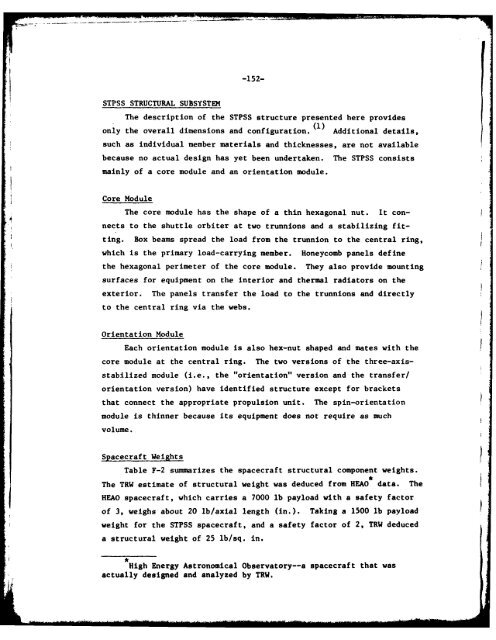A Case Study in NASA-DoD - The Black Vault
A Case Study in NASA-DoD - The Black Vault
A Case Study in NASA-DoD - The Black Vault
You also want an ePaper? Increase the reach of your titles
YUMPU automatically turns print PDFs into web optimized ePapers that Google loves.
-152-<br />
STPSS STRUCTURAL SUBSYSTEM<br />
<strong>The</strong> description of the STPSS structure presented here provides<br />
only the overall dimensions and configuration.<br />
(1)<br />
Additional details,<br />
such as <strong>in</strong>dividual member materials and thicknesses, are not available<br />
because no actual design has yet been undertaken. <strong>The</strong> STPSS consists<br />
ma<strong>in</strong>ly of a core module and an orientation module.<br />
Core Module<br />
<strong>The</strong> core module has the shape of a th<strong>in</strong> hexagonal nut. It connects<br />
to the shuttle orbiter at two trunnions and a stabiliz<strong>in</strong>g fitt<strong>in</strong>g.<br />
Box beams spread the load from the trunnion to the central r<strong>in</strong>g,<br />
which is the primary load-carry<strong>in</strong>g member. Honeycomb panels def<strong>in</strong>e<br />
the hexagonal perimeter of the core module. <strong>The</strong>y also provide mount<strong>in</strong>g<br />
surfaces for equipment on the <strong>in</strong>terior and thermal radiators on the<br />
exterior. <strong>The</strong> panels transfer the load to the trunnions and directly<br />
to the central r<strong>in</strong>g via the webs.<br />
Orientation Module<br />
Each orientation module is also hex-nut shaped and mates with the<br />
core module at the central r<strong>in</strong>g. <strong>The</strong> two versions of the three-axisstabilized<br />
module (i.e., the "orientation" version and the transfer/<br />
orientation version) have identified structure except for brackets<br />
that connect the appropriate propulsion unit. <strong>The</strong> sp<strong>in</strong>-orientation<br />
module is th<strong>in</strong>ner because its equipment does not require as much<br />
volume.<br />
Spacecraft Weights<br />
Table F-2 summarizes the spacecraft structural component weights.<br />
<strong>The</strong> TRW estimate of structural weight was deduced from HEAO data. <strong>The</strong><br />
HEAO spacecraft, which carries a 7000 lb payload with a safety factor<br />
of 3, weighs about 20 lb/axial length (<strong>in</strong>.). Tak<strong>in</strong>g a 1500 lb payload<br />
weight for the STPSS spacecraft, and a safety factor of 2, TRW deduced<br />
a structural weight of 25 lb/sq. <strong>in</strong>.<br />
High Energy Astronomical Observatory--a spacecraft that was<br />
actually designed and analyzed by TRW.
















